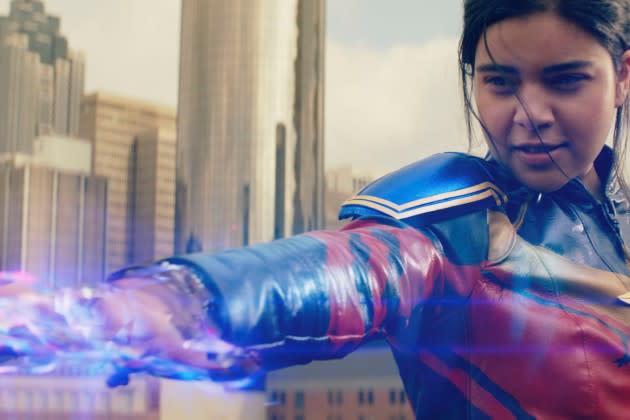Behind the Music of ‘Ms. Marvel’: Laura Karpman Score Is as Colorful as the Disney+ Series Itself

The music of “Ms. Marvel” is as colorful as the bright, splashy visuals of the Disney+ series, and composer Laura Karpman — who has just finished five months scoring it — relished the challenge.
Karpman frames it this way: “How do you bring somebody like a Kamala Khan into the Marvel Universe, give her the kind of dignity and presence of every other major Marvel superhero, and also acknowledge where she came from?”
More from Variety
How NatGeo's 'America the Beautiful' Doc Incorporates Indigenous Musical Sounds
'Ms. Marvel's' Latest Episode Has a Giant Ant-Man Easter Egg
The answer, in part, was a close collaboration with executive producer Sana Amanat, who came with specific musical ideas and even suggested a violinist to contribute unique sounds. She would often spend as much as seven hours a week at the composer’s Los Angeles studio.
Karpman, a five-time Emmy winner who last year scored Marvel’s animated “What If…?”, had already been announced as composer for next year’s big-screen feature “The Marvels” when “Ms. Marvel” (effectively a prequel to “The Marvels”) came her way in February of this year.
“Marvel superhero meets a deep and significant heritage that had to also be a part of the sound of the show,” she says of her overall concept for the score. “It’s about representation, about elevating people who have not yet been seen a certain way cinematically. And when I can help with that, that’s really satisfying for me.”
Kamala Khan (Iman Vellani) is a Pakistani-American teenager and Captain Marvel fan from Jersey City, N.J., who inherits a magical bangle that gives her cosmic-energy powers. Her journey eventually leads her back to her grandmother in Karachi and the unveiling of family secrets related to the partition of India in the 1940s. The sixth and final episode of the series drops on Wednesday.
The superhero side of Kamala would need a traditional orchestra, but her heritage suggested a South Asian musical component. And, Karpman reminds, “she’s a teenager. Kamala’s theme had to be hip, driven by contemporary beats, dhol beats, tabla beats, or both.”
Adding South Asian flavors were a variety of artists, most of them recording remotely in India and Pakistan: musicians playing the stringed sarangi and sursringar, the bansuri flute, mridangam drum, plus two unique soloists: violinist Raaginder, a specialist in Indian classical music, and South Indian-raised vocalist Ganavya Doraiswamy.
“I wrote major themes, sent them out, and then saw what came back,” Karpman says of her world-music performers. “But then they’d do a third or fourth take, and sometimes the most interesting stuff was in those takes, when they would start improvising. It was incredibly exciting.”
Karpman combined these sounds with a 70-piece orchestra, which recorded every week at the Synchron Stage in Vienna; and, for episode 5 (set entirely in Pakistan), an eight-voice choir of South Asian singers singing partially in the Urdu language.
“I brought music and themes that I had written,” she says. “And together, as a group, we came up with the choir sound. Some unbelievably extraordinary things happened in that session. It was lightning in a bottle, not only having to come up with quick ideas based on what was happening in the room, but also what people threw back at me. It was one of the greatest sessions I’ve ever been at in my life.”
That music, which accompanied the powerful train sequence in episode 5, will be included in volume 2 of the “Ms. Marvel” soundtrack, also slated for release Wednesday. (Volume 1, containing music from episodes 1-3, was released on June 22.)
Along with Kamala’s theme, there are secondary themes for the bangle, her heritage, a love theme for Aisha and Hasan (Kamala’s great-grandparents) and more. In addition to mixing all of these acoustic elements, a good deal of production and processing was required.
That a TV series from the Marvel Cinematic Universe is showing viewers the history and tragedy of the region is not lost on Karpman. “When you’re introducing people who have no idea what the partition is, and how destructive the diaspora was, you feel a sense of responsibility,” she says.
“I tried to be as authentic as I could be in collaborating with a lot of different musicians. I bring what I can to it, which is a sophisticated orchestral score combined with these incredible elements from a tradition not native to me. I’m glad they asked me to do it.”
Best of Variety
Sign up for Variety’s Newsletter. For the latest news, follow us on Facebook, Twitter, and Instagram.

